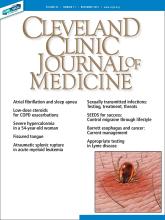Article Figures & Data
Tables
- TABLE 1
Screening recommendations and laboratory testing for common sexually transmitted infections
Organism Disease Screening recommendations Optimal testing method Specimen types Neisseria gonorrhoeae and Chlamydia trachomatis Females: cervicitis
Males: urethritisFemales ≤ 25 years old, annually
Men who have sex with men; consider in young males in high-prevalence areas, annuallyNucleic acid amplification test (NAAT) Females: vaginal or endocervical swab, first-void urine
Males: urethral, rectal, or throat swab; first-void urineMycoplasma genitalium Females: cervicitis
Males: urethritisRoutine screening not recommended NAAT Females: vaginal or endocervical swab, first-void urine
Males: first-void urineTrichomonas vaginalis Females: vaginitis
Males: urethritis, epididymitis, prostatitisRoutine screening not recommended; but women with human immunodeficiency virus infection should be screened annually NAAT Females: vaginal or urine swab, first-void urine
Males: first-void urineAdapted from the US Centers for Disease Control and Prevention, reference 12.
Organism Treatment Alternatives Chlamydia trachomatis Azithromycin 1 g by mouth, 1 dose
or
Doxycycline 100 mg by mouth twice daily for 7 daysErythromycin base 500 mg by mouth every 6 hours for 7 days
or
Erythromycin ethylsuccinate 800 mg by mouth every 6 hours for 7 days
or
Ofloxacin 300 mg by mouth twice daily for 7 days
or
Levofloxacin 500 mg by mouth daily for 7 daysNeisseria gonorrhoeae (uncomplicated infection) Ceftriaxone 250 mg intramuscularly, 1 dose and
Azithromycin 1 g by mouth
Gonococcal conjunctivitis: ceftriaxone 1 g intramuscularly, 1 doseHistory of severe cephalosporin allergy:
Gentamicin 240 mg intramuscularly plus
Azithromycin 2 g by mouth, 1 doseN gonorrhoeae (disseminated infection) Ceftriaxone 1 g intravenously
or intramuscularly every 24 hours
or
Cefotaxime 1 g intravenously every 8 hours
or
Ceftizoxime 1 g intravenously every 8 hours plus
concurrent treatment for chlamydiaCan switch to an oral antibiotic based on
susceptibilities 24–48 hours after clinical
improvement for 7 days of treatmentMycoplasma genitalium Azithromycin 1 g by mouth, 1 dose
or
Azithromycin 500 mg by mouth, 1 dose and then 250 mg by mouth for 4 more days (limited by resistance)Moxifloxacin 400 mg by mouth for 7–14 days Trichomonas vaginalis Metronidazole 500 mg by mouth twice a day for 7 days
or
Metronidazole 2 g by mouth, 1 doseTinidazole 2 g by mouth, 1 dose;
or 1 g by mouth every day for 5 daysAdapted from US Centers for Disease Control and Prevention, reference 7






